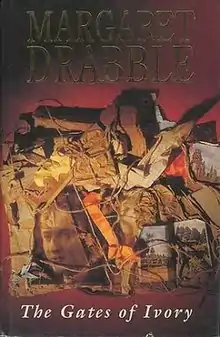The Gates of Ivory
The Gates of Ivory is a 1991 novel by novelist Margaret Drabble.[1] The novel is the third in a series of novels, following The Radiant Way and A Natural Curiosity. The novel continues the stories of several middle aged intellectuals introduced in the last two novels.[2] The novel also introduces a new character, Stephen Cox who is loosely based on J.G. Farrell.[3]

Style
The novel includes metafiction reflecting on the choices Drabble made while writing the novel.[2] The novel also includes a bibliography referencing a number of works which provide background and connections for the rest of the novel.[4]
The novel's narratives that rotate between both the present and flashbacks narratives from each of the main characters.[2] The novel also introduces characters from The Needle's Eye.[2]
Reviews
New York Times reviewer Linda Simon was disappointed with the novel, writing "intellectually stimulating and, as we might expect from Ms. Drabble, very smart. But ideas do not make a novel. Characters do."[2] Publishers Weekly describes the novel as "command[ing] awe even as [Drabble's] subject matter rouses immeasurable stores of pity and terror."[5]
References
- Sutherland, John (5 December 1991). "Drabble's Progress". London Review of Books. p. 18. ISSN 0260-9592. Retrieved 13 March 2016.
- Simon, Linda (10 May 1992). "Rambo, Rimbaud, Which Is Best?". The New York Times Books.
- Prusse, Michael C. (2003). British and Irish Novelists Since 1960. Detroit, Michigan: Gale. ISBN 978-0-7876-6015-4.
- Annan, Gabriele. "Numbers Game". The New York Review of Books. Retrieved 13 March 2016.
- "Fiction Book Review: The Gates of Ivory by Margaret Drabble". PublishersWeekly.com. Retrieved 13 March 2016.